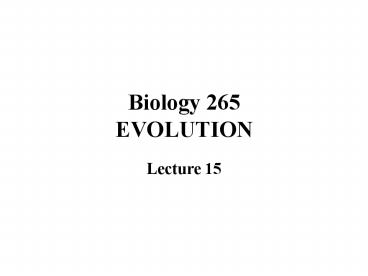Biology 265 EVOLUTION - PowerPoint PPT Presentation
1 / 33
Title:
Biology 265 EVOLUTION
Description:
Manual dexterity (opposable thumb), large forehead and cerebral cortex, ... high encephalization quotient compared to Great Dane (because we bred it to have ... – PowerPoint PPT presentation
Number of Views:135
Avg rating:3.0/5.0
Title: Biology 265 EVOLUTION
1
Biology 265EVOLUTION
- Lecture 15
2
Overview
- Primates
- Out of the trees
- Pelvis
- Brain
- Larynx
- Lots of speculation
- MBP million years before present
3
The tree of life - does it include humans?
4
(No Transcript)
5
Humans Evolved - Homology
- Similar embryos
- Mammary glands
- Vestigial pointed ear
- Nictitating membrane
6
Arboreal Primates
- Binocular vision - 60 MBP
- Manual dexterity (opposable thumb), large
forehead and cerebral cortex, short snout - 50
MBP - Color vision (cone cells in retina) evolved in
all primates helped with depth of field perception
7
Brachiating Apes
- Swinging in trees
- Straightened spine
- Legs parallel to spine
- Preadaptation to bipedalism?
8
(No Transcript)
9
Australopithecus
- 4 - 2.5 MBP
- Brain size not much bigger than chimpanzee (450
cm3) - Did tool use lead to evolution of more manual
dexterity, bipedalism, and intelligence?
10
A. afarensis (Lucy)
11
Hadar, Ethiopia
Lucys homeland 3-3.6 MBP
12
(No Transcript)
13
Climate change
- About 2-3 MBP cooling temperatures reduced
tropical woodland - Hominids may have adapted to savannas
- Modern humans finally emerging from Africa about
100,000 BP
14
(No Transcript)
15
(No Transcript)
16
(No Transcript)
17
Pelvis and Bipedalism
- Many possible advantages - tool use, vision,
locomotion - Also costs (trade-off)
- Narrower birth canal due to strengthening pelvis
problematic because of bigger cranium
Obstetrical dilemma - Infants born early in development
- Long maternal association - learning?
18
Genus Homo
- 2.33 MBP
- Closely associated with crudely flaked stone
tools - the oldest, securely dated co-occurrence of a
human fossil and stone artifacts in Africa.
19
Early tools
2.6 MBP
1.6 MBP
20
H. erectus
- This skull was found in Kenya
- Dated around 1.7 MBP
- Brain 850 cm3
21
To H. sapiens
- No clear dividing line
- Archaic H. sapiens found in Africa
- 500,000 BP ?
22
China - H. sapiens?
- two skulls found near the Han river in Yunxian,
an area of central China. - The Yunxian skulls are between 350,000 and
500,000 BP?
23
Multiregional or Out-of-Africa
- The geographic origins of Homo sapiens are
controversial - Multiregional dispersal of early Homo set a
complex stage for Homo sapiens to emerge at
connected points across much of the Old World. - Africa both the early and later species of Homo
had the ability to disperse across the
continents.
24
Africa
- Given that Homo sapiens fossils appear to be much
older in Africa than on any other continent. - Having probably emerged in Africa, Homo sapiens
dispersed to Eurasia, replacing older populations
of Homo.
25
Lower sea levels may have helped dispersal
26
(No Transcript)
27
Brain size
- Increased dramatically about 2.5 MYA at about
time of first tools and appearance of Homo - Australopithecus, 3 MYA, 450 cm3, maybe stone
tools - Homo habilis, 3 MYA, 650-750 cm3
- Homo erectus, 1.8 MYA, 800-900 cm3, language??
28
Brain size cont.
- Homo sapiens sapiens, 100,000 BP, 1,400 cm3 (our
brain size) - Homo sapiens neanderthalensis, existed at same
time as H.s.sapiens and if anything had a bigger
brain - Cro-Magnon man, 40,000 BP is a fully modern human
that may have overlapped with Neanderthals.
29
Encephalization Quotient
- Compares brain to body size ratio
- In humans compared to other primates, the ratio
is 3 - But chihuahua has high encephalization quotient
compared to Great Dane (because we bred it to
have a small body) - Primate brains grow at same rate as other species
but their bodies grow slower - Human brain continues to grow for longer
30
Brains are expensive
- Brain consumes 20 of bodies energy but only 2
of total body weight (figures based on human at
rest). - Brains dont rest
- Brains use roughly the energy consumed by a light
bulb all the time (even while asleep) - Lots of fatty myelin - expensive material (meat
eating needed?)
31
Prefrontal cortex
- Human visual cortex (at back of brain) is
relatively small - similar to apes - Prefrontal cortex is very large but does not
directly take sensory information - What does it do?
- Phineas Gage - 1848 an iron bar pierced his head.
Survived, walked, talked, but personality
altered.
32
Why big brains?An adaptation for what?
- Not essential for social behavior or hunting
- Sexual selection? Song?
- But why pick on brain size, and why only in
humans?
33
Neoteny
- Humans resemble baby apes
- Arrested development
- Little sexual dimorphism (e.g. compare large
canines of male gorillas) - Humans, the naked apes































